School Auction Gold: Student Art Projects
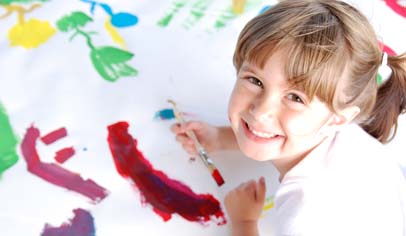
Projects created by elementary school students brought in more than $8,000 for a New York City parent group.
Keepsakes created by students make extremely popular auction items. At an auction for P.S. 166 in Manhattan, dozens of pieces of original artwork created by the elementary schoolers raised more than $8,000, a significant part of the schoolwide auction total of $50,000. Read on below the class projects and tips to learn more about how the P.S. 166 Parent Association cashed in.
Creative Class Projects
Decoupage pewter trays
Pewter trays were sprayed with primer and covered with enamel paint. Student drawings (copied and reduced to 2-inch-by-3-inch rectangles) were sprayed with clear acrylic, then attached and sealed. Created by a 2nd grade class; three trays sold individually for $200, $375, and $400, for a total of $975.
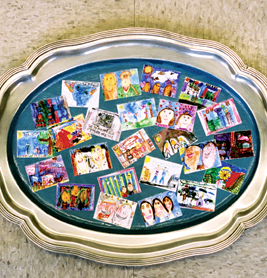
Animal bookshelf
An unfinished wooden bookshelf was painted white. The top, sides, and the front of each shelf were decorated with pictures of animals drawn by the children. The animals were cut out and glued to the bookshelf with several coats of sealant. Created by a 1st grade class; sold for $500.

Join the PTO Today community (it's free) for access to resources, giveaways and more
Shower curtain
Parents divided a clear shower curtain into 24 squares, one for each student and an extra to write the class number and year. Each child used colored permanent markers to draw a self-portrait in his square. Created by a kindergarten class; sold for $400.
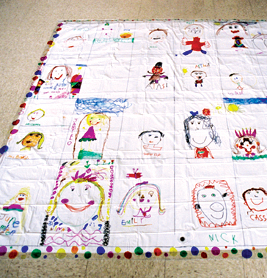
Andy Warhol-style self-portraits
Each student painted a self-portrait on a 6-inch by 8-inch hard canvas using a palette of acrylic paint in the blues and greens family. These were then mounted to a larger pre-stretched canvas with thick double-stick tape. Created by a 3rd grade class; sold for $1,300.

Neighborhood watercolors
Students made four large and two small drawings of P.S. 166 and the neighborhood. They used crayons washed over with water. Created by a kindergarten class; sold individually for $90 to $500, for a total of $1,540.
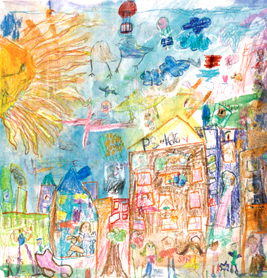
Alphabet mirror
A standard white door mirror was decorated around the edges with the first initial of each child in the class. The students painted wooden letters and decorated them with colored rhinestones. The letters were coated and sealed with shiny sealant and glue around the mirror with a glue gun. Created by a 4th grade class; sold for $150.
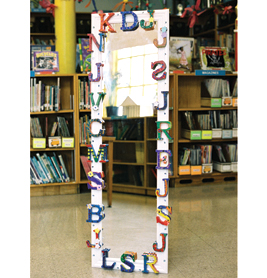
Kite
The kite was chosen as a timeless and ageless toy. It was designed and constructed by a parent with nylon and wood. Each child designed a felt symbol of identity, which was then sewed to the kite. Although meant to be displayed, it actually will fly. Created by a 2nd grade class; sold for $350.
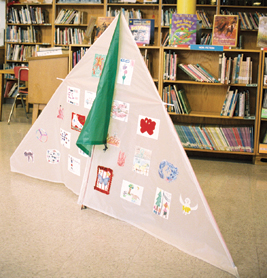
Thumbprint stepstool
The stepstool was decorated using paints and markers. Each child added his thumbprint, which was turned into an animal by the teacher using markers. Created by a prekindergarten class; sold for $70.
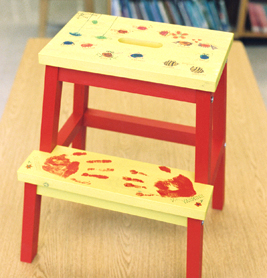
Weather watercolors
Using oil pastels and watercolors, five children each created a framed piece based on a class study of weather. The panels were themed Windy, Snowy, Cloudy, Rainy, and Sunny. The works were mounted and set in maple frames. Created by a 1st grade class; sold individually for $300 to $500, for a total of $2,025.
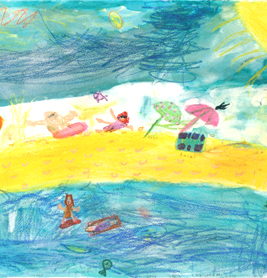
Our Iroquois Names
This book was put together to take advantage of the students creative writing skills and because the class was studying Native American legends. Each student chose an Iroquois name and wrote and illustrated a story and poem about its origin. These were typed and printed on quality card stock and bound in a spiral book with a laminated cover. Created by a 4th grade class; sold for $200.
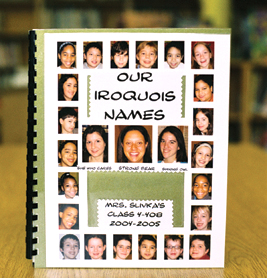
Word Slam: CD of poems
Since this class was studying poetry, a parent recorded each child reading a favorite poem he had written. CDs were burned with the poetry interspersed with musical interludes. Another parent took photos of each child to create a CD cover with their pictures. Created by a 3rd grade class; 38 CDs were sold in advance of the auction for $20 each, for a total of $760.
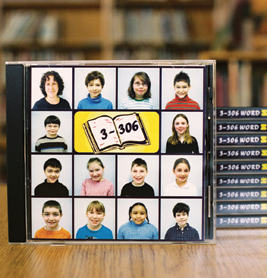
Tips for Creating Art That Sells
Get teachers involved. Ask for the teachers participation and cooperation, whether it's to come up with an idea for a project shed like the class to work on or to determine a theme based on something being studied in class. You need your teacher on board so that the children can work on the project during class time.
Pick something that’s age-appropriate. That way the project will be done by the children and not by parents, making it more appealing.
Make the project durable. If it's a bowl or tray to be used, cover any decoupage with a waterproof sealant. Use permanent markers, paint, and sealant designed specifically for the type of material you're working with, whether it's plastic, wood, metal, or something else. Ask at a local craft or hardware store for product recommendations.Label it. Be sure to put the school, class number, and date somewhere on the project so the buyer will be able to remember it forever.
Have a theme. The finished project will look nicer if theres a consistent element, and its often easier for young children to be artistic when they're told to draw a self-portrait or an animal, for example, than when they're just told to draw anything they would like. But its also important to allow for individual creativity.
Think outside the gavel. Class projects don't have to be sold at auctions only; consider promoting them at an annual school dinner, show, or any other schoolwide fundraiser.
The P.S. 166 Parent Association’s Student Art Auction Success
The bidding was fierce at a Saturday night auction in March for a set of six framed, hand-painted watercolors. The artists, however, weren't there to watch all the excitement; they were home in bed. After all, they were only 5 years old.
By the end of the night, dozens of pieces of original artwork done by these kindergartners and their fellow elementary school students at P.S. 166 on Manhattan’s Upper West Side had raked in more than $8,000 as part of a schoolwide auction total of $50,000.
The six paintings alone sold for $1,540—more than two high-profile items combined: a wine tasting for 25 people and tickets to see a Temptations and Four Tops concert, complete with backstage passes and photo op with the performers.
At many New York City schools, both public and private, parent groups hold an annual auction as a major fundraiser. Along with donations of gift certificates from local businesses and restaurants, packaged gift baskets, and services offered by parents (from chess lessons to sessions with a personal trainer), it's common for each class to make a unique project to sell during the live or silent auction. These collaborative masterpieces include hand-painted footstools with each child’s thumbprint, bookshelves decoupaged with student drawings, decorated toy boxes, and books and CDs of original stories and poetry.
The P.S. 166 Parent Association sends out a list of suggested projects to class representatives early in the year and encourages parents, teachers, and students to get creative. Many projects start with inexpensive items ready for decorating. They’re acquired from unfinished-wood furniture stores, craft suppliers, even Ikea and Wal-Mart.
Some projects are purely whimsical (for example, a decorative kite made for hanging, not flying), while others relate to what the students are learning in school (a book of Iroquois names). What’s great about these collaborative efforts is that everyone gets involved to give something back to the school, says Deborah Lott, cochair of the P.S. 166 PA auction. Even better, she adds, they raise big bucks for PA-supported enrichment and tutoring programs, computer labs, science kits, musical instruments, books, and other supplies.
Parents have been known to spend thousands on a glitter-and-glue-encrusted object they don’t need and can’t use, simply because their kids participated and they want to own it or because they want to make a substantial donation to the school. “The children get very caught up in the projects and have a lot of pride in their workmanship,” Lott says. “They hear all about the auction, and it’s their only contribution; they want to feel they’re part of it." The only problem, she says, is that each child knows mom and dad are going to the auction, and they want parents to bring home the project they participated in. But not everyone gets the prize.
One parent who got carried away was Buffy Perry. She desperately wanted the Andy Warhol-style self-portraits done in fluorescent blue-and-green tones by her son Zachary's 3rd grade class; they go with the Statue of Liberty retrospective done in oranges and reds by her daughter Taylor’s class for the auction three years ago.
After a heated bidding war, Perry beat out another family with a total of $1,300. “I couldn’t quite believe we spent so much, but I had promised Zachary, so we had no cap,” she says. “The look on my son’s face when I told him we won made it money well-spent.” Plus, she says, it’s a beautiful piece of art that hangs in the entryway to her home, opposite her daughter’s. “It was a great project and a great cause, and it will have lasting memories. It will be fun for Zachary to see what his interpretation of himself was at 8 when he’s 18.”
Artists at Work
The process of creating auction items can be a fun class experience. One Tuesday afternoon before the auction, the first-floor hallway of the school was covered with a clear shower curtain. Excited kindergartners in class K-102 decorated it with their own renditions of themselves.
While many of her classmates drew simple round circles, added ears, mouth, nose, and eyes, and quickly signed their names, Annabelle Schultz took her time. The 5-year-old carefully shaped her mouth like a bright red heart, added spidery black eyelashes, long brown hair slightly flipped at the ends, and earrings, all with a background of spring flowers. Nearby, Atash Massiri drew himself as a vampire—that year’s Halloween costume.
Down the hall, kindergarten teacher Stephanie Pappas laid out large pieces of paper on several tables and had students rotate to each, filling in details of their neighborhoods with crayons. “This is a real group effort,” she explained as the children put in a sun, flowers, rainbows, stores, dogs, even artist Christo’s saffron gates that were hanging in nearby Central Park.
The project reflected this year’s study of the senses and the role of the children in their communities, she explained. “It led us to talk about many things, including how each of us gets to school, the sounds we hear, the weather, and what we see all around us.” Each child also hid himself in the pictures, in the manner of Where’s Waldo?
The payoff, Pappas said, comes when the children see their work framed. “They’re always amazed. They say, ‘Wow! I made fancy art.’”
In the past, some parents have purchased the class projects at the auction and then donated them back to the classroom or to the school for everyone’s enjoyment. Pappas still has the yellow director’s chair her 3rd graders decorated for the auction two years ago, which parents chipped in to buy.
“The kids love to come back to visit it,” she says. “They’re proud of their contributions.”
Originally posted in 2005 and updated regularly.






















